Grumman F4F Wildcat Video
More F4F Wildcat Videos 1 2 3 - Grumman F4F Wildcat Pictures
|
|
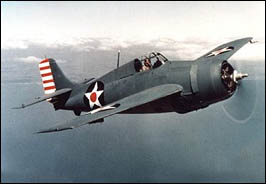 |
Crew: 1 |
Role: Fighter
First flight: 2 September 1937
Introduced: December 1940
Retired: 1945
Primary users: United States Navy, United States Marine Corps, Royal Navy, Royal Canadian Air Force
Number built: 7,722
 (Image: F4F-3 Wildcat of Lt. Butch O'Hare, April 1942)
(Image: F4F-3 Wildcat of Lt. Butch O'Hare, April 1942)
The Grumman F4F Wildcat was an American carrier-based fighter that began service with both the United States Navy and the Fleet Air Arm in 1940. Although first used in combat by the British in Europe, the Wildcat would become the primary carrier fighter for the first year and a half of the United States Navy's involvement in World War II in the Pacific Theater. The FM Wildcat, built by General Motors, remained in service throughout the remainder of the war on escort carriers, where larger and heavier fighters could not be used.
Design and development
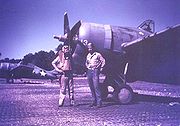 (Image: Grumman F4F-4 of VF-11, Guadalcanal 1942)
(Image: Grumman F4F-4 of VF-11, Guadalcanal 1942)
The F4F-1 began as an unbuilt biplane design entered in a U.S. Navy competition, being beaten by the monoplane Brewster F2A-1 design. This resulted in its complete remodeling into the monoplane XF4F-2. This was evaluated against the Buffalo, but although the XF4F-2 was marginally faster, the Buffalo was otherwise superior and was chosen for production. Grumman's prototype was then rebuilt as the XF4F-3 with new wings and tail and a supercharged version of the Pratt & Whitney R-1830 "Twin Wasp" radial engine. Testing of the XF4F-3 led to an order for F4F-3 production models, the first of which was completed in February 1940. France also ordered the type, powered by Wright R-1820 "Cyclone 9" radial engines, but France fell before they could be delivered and they ultimately went to the British Royal Navy, which named them "Martlet I"s. Both the British aircraft and the U.S. Navy's F4F-3 with an armament of four .50 caliber Browning machine guns, joined active units in 1940.
All versions of the Wildcat used fuselage mounted, hand-cranked landing gear with a relatively narrow track, making landing accidents, where the landing gear were not fully locked into place, distressingly common. This unusual main landing gear design was originally designed by Grover Loening, for his firm's aircraft in the 1920s, and as Leroy Grumman had worked for Loening before starting up his own company, it was readily licensed to Grumman and was used earlier on all of Grumman's fighter biplanes (from the FF-1 through the F3F) of the 1930s and on the J2F Duck amphibious biplane.
The name "Wildcat" was officially adopted on 1 October 1941.
Operational history
Royal Navy
 (Image: Grumman F4F-4 Wildcat of VF-41, early 1942)
(Image: Grumman F4F-4 Wildcat of VF-41, early 1942)
The F4F was taken on by the British Fleet Air Arm as part of an interim replacement for the Fairey Fulmar; navalised Supermarine Spitfires not being available because of the greater need of the Royal Air Force. In the European theater, the Wildcat scored its first combat victory on Christmas Day 1940, when a land-based Martlet (as the type was then known in British service) destroyed a Junkers Ju 88 bomber over the Scapa Flow naval base. This was the first combat victory by a US-built fighter in British service in World War II. The type also pioneered combat operations from the smaller escort carriers.
Six Martlets went to sea aboard the converted ex-German merchant vessel HMS Audacity in mid-1941 and shot down several Luftwaffe Fw 200 Condor bombers during highly effective convoy escort operations. These were the first of many Wildcats to see shipboard combat. The Fleet Air Arm was later to abandon the practice of using its own unique names for US-provided aircraft in British naval service, and began to use the U.S. Navy's aircraft names instead.
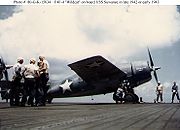 (Image: Grumman F4F-4 Wildcat on board of escort carrier USS Suwannee
(CVE-27) in late 1942)
(Image: Grumman F4F-4 Wildcat on board of escort carrier USS Suwannee
(CVE-27) in late 1942)
The MK.III variant was not equipped with folding wings and was only used for land-based operations.
U.S. Navy and Marines
The Wildcat was outperformed by the Mitsubishi Zero, its major opponent in the early part of the Pacific Theater, but held its own partly because of its ability to absorb far more damage. With relatively heavy armor and self-sealing fuel tanks, the Grumman airframe could survive far more than its lightweight, unarmored Japanese rival. Many U.S. Navy fighter pilots also were saved by the F4F's ZB homing device, which allowed them to find their carriers in poor visibility, provided they could get within the 30-mile (48 km) range of the homing beacon.
In the hands of an "expert pilot" using tactical advantage, the Wildcat could prove to be a difficult foe even against the formidable Zero. After analyzing Fleet Air Tactical Unit Intelligence Bureau reports describing the new carrier fighter, USN Commander "Jimmy" Thach devised a defensive strategy that allowed Wildcat formations to act in a coordinated maneuver to counter a diving attack, called the "Thach Weave."
Four U.S. Marine Corps Wildcats played a prominent role in the defence of Wake Island in December 1941. USN and USMC aircraft were the fleet's primary air defence during the Battles of Coral Sea and Midway and, land-based Wildcats played a major role during the Guadalcanal Campaign of 1942-43. It was not until 1943 that more advanced naval fighters capable of taking on the Zero on more even terms, the F6F Hellcat and F4U Corsair, reached the South Pacific theatre.
The Japanese ace Saburo Sakai describes the Wildcat's ability for absorbing damage:
“ I had full confidence in my ability to destroy the Grumman and decided to finish off the enemy fighter with only my 7.7 mm machine guns. I turned the 20 mm cannon switch to the 'off' position, and closed in. For some strange reason, even after I had poured about five or six hundred rounds of ammunition directly into the Grumman, the airplane did not fall, but kept on flying. I thought this very odd - it had never happened before – and closed the distance between the two airplanes until I could almost reach out and touch the Grumman. To my surprise, the Grumman's rudder and tail were torn to shreds, looking like an old torn piece of rag. With his plane in such condition, no wonder the pilot was unable to continue fighting! A Zero which had taken that many bullets would have been a ball of fire by now. ”
Grumman's Wildcat production ceased in early 1943 to make way for the newer F6F Hellcat, but General Motors continued producing Wildcats for both U.S. Navy and Fleet Air Arm use. From 1943 onward, Wildcats were primarily assigned to escort carriers ("jeep carriers") as larger fighters such as the Hellcat and the Vought F4U Corsair were needed aboard fleet carriers, and the Wildcat's slower landing speed made it more suitable for shorter flight decks. At first, GM produced the FM-1 (identical to the F4F-4, but with four guns). Production later switched to the improved FM-2 (based on Grumman's XF4F-8 prototype) optimized for small-carrier operations, with a more powerful engine, and a taller tail to cope with the torque.
In all, 7,860 Wildcats were built. The British received 300 Eastern Aircraft FM-1s as the Martlet V in 1942/43 and 340 FM-2s as the Wildcat VI. In total nearly 1,200 Wildcats would serve with the FAA. By January 1944, the Martlet name was dropped and the type was identified as "Wildcat."
During the course of the war, Navy and Marine F4Fs and FMs flew 15,553 combat sorties (14,027 of these from aircraft carriers), destroying 1,327 enemy aircraft at a cost of 191 Wildcats (an overall kill-to-loss ratio of 6.9:1). True to their escort fighter role, Wildcats dropped only 154 tons of bombs during the war.
Variants
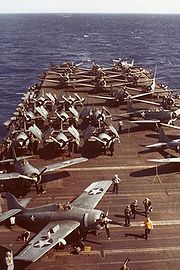 (Image: Grumman F4F-4 Wildcats on USS Wasp 1942)
(Image: Grumman F4F-4 Wildcats on USS Wasp 1942)
F4F-1/-2
The original Grumman F4F-1 design was a biplane, which proved inferior to rival designs, necessitating a complete redesign as a monoplane named the F4F-2. This design was still not competitive with the Brewster F2A Buffalo which won initial U.S. Navy orders, but when the F4F-3 development was fitted with a more powerful version of the engine, a Pratt & Whitney Twin Wasp R-1830-76, featuring a two-stage supercharger, it showed its true potential.
F4F-3
U.S. Navy orders followed as did some (with Wright Cyclone engines) from France; these ended up with the Royal Navy's Fleet Air Arm after the fall of France and entered service on the 8 September 1940. These aircraft, designated by Grumman as G-36A, had a different cowling from other earlier F4Fs and fixed wings, and were intended to be fitted with French armament and avionics following delivery. In British service initially the aircraft were known as the Martlet I, but not all Martlets would be to the exact same specifications as U.S. Navy aircraft. All Martlet Is featured the four .50-caliber (12.7 mm) M2 Browning machine guns of the F4F-3 with 450 rounds per gun. The British directly ordered and received a version with the original Twin Wasp, but again with a modified cowling, under the manufacturer designation G-36B. These aircraft were given the designation Martlet II by the British. The first 10 G-36Bs were fitted with non-folding wings and were given the designation Martlet III. These were followed by 30 folding wing aircraft (F4F-3As) which were originally destined for the HAF, which were also designated Martlet IIIs. On paper the designation changed to Marlet III(A) when the second series of Martlet III was introduced.
Poor design of the armament installation on early F4Fs caused these otherwise reliable machine guns to frequently jam, a problem common to wing-mounted weapons of many U.S. fighters early in the war. It was an F4F-3 flown by Lt. Edward O'Hare that in a few minutes shot down five Mitsubishi twin-engine bombers attacking USS Lexington off Bougainville on 20 February 1942. But contrasting with O'Hare's performance, his wingman was unable to participate because his guns would not function.
A shortage of two-stage superchargers lead to the development of the F4F-3A, which was basically the F4F-3 but with a 1,200 hp (890 kW) Pratt & Whitney R-1830-90 radial engine with a more primitive single-stage two-speed supercharger. The F4F-3A, which was capable of 312 mph (502 km/h) at 16,000 ft (4,900 m), was used side by side with the F4F-3, but its poorer performance made it unpopular with U.S. Navy fighter pilots. The F4F-3A would enter service as the Martlet III(B).
At the time of Pearl Harbor, only USS Enterprise had a fully-equipped Wildcat squadron, VF-6 with F4F-3As. The USS Enterprise was then transferring a detachment of VMF-211, also equipped with F4F-3s, to Wake. The USS Saratoga was in San Diego, working up for operations of the F4F-3s of VF-3. Eleven F4F-3s of VMF-211 were at the Ewa Marine Air Corps Station on Oahu; nine of these were damaged or destroyed during the Japanese attack. The detachment of VMF-211 on Wake lost seven Wildcats to Japanese attacks on 8 December, but the remaining five put up a fierce defense, making the first bomber kill on 9 December. The destroyer Kisaragi was sunk by the Wildcats, and the Japanese invasion force retreated.
In May 1942 the F4F-3s of VF-2 and VF-42, on board of USS Yorktown and USS Lexington, participated in the Battle of the Coral Sea. The USS Lexington and USS Yorktown fought against the Zuikaku, Sh?kaku and the light carrier Sh?h? in this battle, in an attempt to halt a Japanese invasion of Port Moresby on Papua. During these battles, it became clear that attacks without fighter escort amounted to suicide, but that the fighter component on the carriers was completely insufficient to provide both fighter cover for the carrier and an escort for an attack force. Most U.S carriers carried less than 20 fighters.
F4F-3S
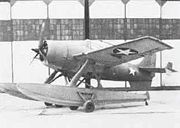 (Image: The Grumman F4F-3S "Wildcatfish", a floatplane version
of the F4F-3. Edo Aircraft fitted one F4F-3 with twin floats)
(Image: The Grumman F4F-3S "Wildcatfish", a floatplane version
of the F4F-3. Edo Aircraft fitted one F4F-3 with twin floats)
This floatplane version of the F4F-3 was developed for use at forward island bases in the Pacific, before the construction of airfields. It was inspired by appearance of the A6M2-N "Rufe", a modification of the Mitsubishi A6M2 "Zeke." BuNo 4083 was modified to become the F4F-3S "Wildcatfish". Twin floats, manufactured by Edo, were fitted. To restore the stability, small auxiliary fins were added to the tailplane. Because this was still insufficient, a ventral fin was added later.
The F4F-3S was first flown 28 February 1943. The weight and drag of the floats reduced the maximum speed to 241 mph. As the performance of the basic F4F-3 was already below that of the A6M, the F4F-3S was clearly of limited usefulness. Anyway, the construction of the airfields at forward bases by the "Seabees" was surprisingly quick. Only one was converted.
F4F-4
A new version, the F4F-4, entered service in 1942 with six machine guns and folding wings which allowed more aircraft to be crammed on a carrier, increasing the number of fighters that could be parked on a surface by more than a factor of 2. The F4F-4 was the definitive version that saw the most combat service in the early war years, including the Battle of Midway. The F4F-3 was replaced by the F4F-4 in June 1942, during the Battle of Midway; only VMF-221 still used them at that time.
This version was less popular with American pilots because the same amount of ammunition was spread over two additional guns, decreasing firing time. With the F4F-3's four 50-caliber guns and 450 rounds per gun, pilots had 34 seconds of firing time; six guns decreased ammunition to 240 rounds per gun, which could be expended in less than 20 seconds. The increase to six guns was attributed to the Royal Navy, who wanted greater firepower to deal with German and Italian foes. Jimmy Thach is quoted as saying, "A pilot who cannot hit with four guns will miss with eight." Extra guns and folding wings meant extra weight, and reduced performance: the F4F-4 was capable of only about 318 mph (512 km/h) at 19,400 ft (5,900 m) Rate of climb was noticeably worse in the F4F-4, while Grumman optimistically claimed the F4F-4 could climb at a modest 1,950 ft (590 m) per minute, in combat conditions, pilots found their F4F-4s capable of ascending at only 500 to 1,000 feet (300 m) per minute. Moreover, the F4F-4's folding wing was intended to allow five F4F-4s to be stowed in the space required by two F4F-3s. In practice, the folding wings allowed an increase of about 50% in the number of Wildcats carried aboard U.S. fleet aircraft carriers. A variant of the F4F-4, designated F4F-4B for contractual purposes, was supplied to the British with a modified cowling and Wright Cyclone engine. These aircraft received the designation of Martlet IV.
F4F-7
The F4F-7 was a photographic reconnaissance variant, with armor and armament removed. It had non-folding "wet" wings that carried an additional 555 gallons of fuel for a total of about 700 gallons, increasing its range to 3,700 miles. A total of 21 were built.
Martlet Mk.I
At the end of 1939 Grumman received a French order for 81 aircraft of model G-36A, to equip the new carriers Joffre and Painlevé. The main difference with the basic model G-36 was due to the unavailability for export of the two-stage supercharged engine of F4F-3. The G-36A was powered by the nine-cylinder, single-row R-1820-G205A radial engine, of 1,200 hp. This was combined with a Hamilton Standard constant-speed propeller. The first deliveries featured highly polished, shiny propeller blades.
The G-36A had also French instrumentation, radio, and gunsight. The throttle was modified to conform to French pre-war practice: the throttle lever was moved towards the pilot, (i.e., backward), to increase engine power. The armament was French, six 7.5mm Darne guns. The first G-36A was flown on 11 May 1940.
After the defeat of France, all contracts were taken over by Britain. The throttle was modified again, four 0.50 guns were installed in the wings, and most traces of the original ownership removed. The Martlets were modified for British use by Blackburn, which continued to do this for all later marks. British gunsights, catapult spools, and other items were installed. After initial attempts to fit British radio sets, it was decided to use the much superior American equipment.
The first ones entered service in August 1940, with No 804 squadron, then stationed at Hatson in the Orkneys. The Martlet Mk.I did not have a wing folding mechanism, and was therefore only used from land bases.
Martlet Mk.II
Before the Fleet Air Arm took on charge the Martlet Mk.Is it had already order 100 G-36B fighters. The British chose the Pratt & Whitney R-1830-S3C4-G engine to power this aircraft; this too had a single-stage supercharger. The FAA decided to accept a delay in delivery to get folding wings, which were vitally important if the Martlet was to be used from British carriers with their small hangar decks. Nevertheless, the first 10 received had fixed wings. The first Martlet with folding wings was not delivered before August 1941.
In contrast to F4F-3, the British aircraft were fitted with armour and self-sealing fuel tanks. The Mk.II also had a larger tailwheel. For carrier operations, the 'sting' tail hook and attachment point for the American single-point catapult launch system were considered important advantages. Nevertheless, the Martlets were modified to have British-style catapult spools.
The Martlet was the only single-seat, monoplane carrier fighter available to the British fleet until the introduction of the Sea Hurricane II in 1942.
The majority of the Martlet Mk.IIs were sent to the Far East. The first shipboard operations of the type in British service were in September 1941, on board of HMS AudacityTemplate:WP Ships HMS instances, a very small carrier with a carrier deck of 128m by 18m, no lifts and no hangar deck. The six Wildcats were parked on the deck at all times. On its first voyage, it served as escort carrier for a convoy to Gibraltar. On 20 September, a German Fw 200 Condor was downed. On the next voyage, four Fw 200s fell to the guns of the Martlets. Operations from the Audacity also demonstrated that the fighter cover was useful against U-boats. Audacity was sunk by an U-boat on 21 December 1941, but it had proven the usefulness of escort carriers.
In May 1942, the No. 881 and 882 squadrons on HMS Illustrious, participated in operations against Madagascar. In August 1942. No. 806 on HMS Indomitable provided fighter cover for a convoy to Malta. Later in that year they participated in the landings in French North Africa.
Martlet Mk.III
The first 30 F4F-3As were released for sale to Greece, after the Italian invasion in November 1940. However, at the defeat of Greece in April 1941 the aircraft had only reached Gibraltar. They were taken over by the FAA as Martlet Mk.III. Because these aircraft did not have folding wings, they were only used from land bases. They served in a shore-based role in the Western Desert.
Operators
Canada: Royal Canadian Air Force
United Kingdom: Fleet Air Arm
United States: United States Navy, United States Marine Corps
Survivors
(Image: F4F3 in Guadalcanal Diorama at the Pacific Aviation Museum,
Honolulu, HI USA)
-F4F-3 "Wildcat" (Bu. No. 12260) owned by John C. Dimmer and registered as N3210D. Formerly loaned to the Olympic Flight Museum, Olympia, Washington and currently loaned to the Pacific Aviation Museum. The aircraft is in flying condition having been restored by David Kensler in 1995.
-The sole surviving Martlet I at the Fleet Air Arm Museum in Yeovilton, Somerset, UK.
-A Wildcat is displayed at the Cradle of Aviation Museum at One Davis Avenue, Garden City, NY, on loan from the National Museum of Naval Aviation.
-A F4F-3 (Bu. No. 3872) displayed at PNS in the pre-war markings of VF-72.
-A F4F-3 (Bu. No. 12320) restored in the markings of Edward Henry "Butch" O'Hare and displayed in the Chicago O'Hare airport). The Grumman F4F-3 on display was recovered virtually intact from the bottom of Lake Michigan, where it sank after a training accident in 1943 when it went off the training aircraft carrier USS Wolverine (IX-64). The aircraft was restored by the Air Classics Museum to look like the one that O'Hare flew, and is exhibited in Terminal Two at the west end of the ticketing lobby.
-A F4F-3A (3969) also at PNS.
-A F4F-4 (Bu. No. 11828) in the San Diego Air and Space Museum on loan from the National Museum of Naval Aviation at Pensacola, Florida.
-A F4F-4 (Bu. No. 12114) in the Marine Corps Museum at Quantico, Virginia.
-A FM-1 in the National Air and Space Museum at NAS Pensacola, Florida.
-A FM-1 (Bu. No. 15392) at the National Air & Space Museum, Washington DC.
-A FM-2 (Bu. No. 47030) N315E. This is reputedly the aircraft that served as photo source for the Kagero detail photographs.
-A FM-2 (Bu. No. 47160) N551TC (ex-N2876D). Displayed in 1980 at an air show at Holloman AFB, New Mexico and later at the Lone Star Flight Museum.
-A FM-2 (Bu. No. 55585) N681S. Owned by Gerald McMasters and once part of the Commemorative Air Force. This aircraft crashed on 18 October 2003, killing the pilot. The aircraft had been taking part in a photo flight following the first day of the 2003 Wings Over Houston air show.
-A FM-2 (Bu. No. 55627) N7906C. Once part of Ed Maloney's Air Museum at Chino, California. Now as N47201.
-A FM-2 (Bu. No. 74161) at the Admiral Nimitz Museum, Fredricksburg, Texas.
-A FM-2 (Bu. No. 74560) N902523 at the Champlin Fighter Museum.
-A FM-2 (Bu. No. 86581) N1PP (ex-N86581). Once in a paint scheme to represent an FM-2 from the USS Steamer Bay. Now in the Kalamazoo Aviation History Museum in Michigan.
-A FM-2 (Bu. No. 86680) N11FE (ex-NX5558, N777A). Once owned by Dick Foote and painted like a Wildcat operating from USS Tulage.
-A FM-2 (Bu. No. 86690) N20HA. Once a crop sprayer in Phoenix, Arizona. In 1978 to the Naval Aviation Museum.
-A FM-2 (Bu. No. 86747) N68843. On display above the lobby at the National Museum of Naval Aviation, PNS.
-A FM-2 (Bu. No. 86774) N7835L at the Air Museum Planes of Fame.
-A FM-2P (Bu. No. 86777) N5HP (ex-N90541) owned at one time by Howard Pardue.
-A FM-2 (Bu. No. 86816) N5833. Aircraft is painted in the marking of fighters operated from the USS Wake Island during World War II, also owned, like 55585, by Gerald McMasters.
-A FM-2 (Bu. No. 86960) N18P at the Cavanaugh Flight Museum in Addison, Texas. The aircraft is flyable and performs in air shows. Served as an FM-2 detail source for Squadron/Signal's Wildcat Walk Around.
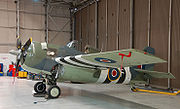 (Image: A Grumman Martlet/Wildcat preserved at the Imperial War Museum
Duxford)
(Image: A Grumman Martlet/Wildcat preserved at the Imperial War Museum
Duxford)
-A FM-2 BU86711 presently in flying condition at Duxford, England.
Specifications (F4F-3)
General characteristics
-Crew: 1
-Length: 28 ft 9 in (8.76 m)
-Wingspan: 38 ft (11.58 m)
-Height: 11 ft 10 in (3.60 m)
-Loaded weight: 7,000 lb (3,176 kg)
-Powerplant: 1× Pratt & Whitney R-1830-76 double-row radial engine, 1,200 hp (900 kW)
Performance
-Maximum speed: 331 mph (531 km/h)
-Range: 845 mi (1,360 km)
-Service ceiling 39,500 ft (12,000 m)
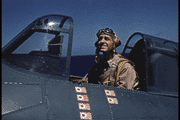 (Image: Grumman F4F-4 Wildcat with six kill markings (1942))
(Image: Grumman F4F-4 Wildcat with six kill markings (1942))
Armament
-Guns: 4 × 0.50 in (12.7 mm) M2 Browning machine guns, 450 rounds/gun
-Bombs: 2 × 100 lb (45 kg) bombs and/or 2 × 58gal. drop tanks
Specifications (F4F-4)
General characteristics
-Crew: 1
-Length: 28 ft 9 in (8.8 m)
-Wingspan: 38 ft 0 in (11.6 m)
-Height: 9 ft 2.5 in (2.8 m)
-Wing area: 260 ft² (24.2 m²)
-Empty weight: 5,760 lb (2,610 kg)
-Max takeoff weight: 7,950 lb (3,610 kg)
-Powerplant: 1 x Pratt & Whitney R-1830-86 double-row radial engine, 1,200 hp (900 kW)
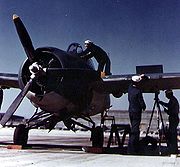 (Image: F4F-4 receives maintenance of its six M2 Browning machine guns)
(Image: F4F-4 receives maintenance of its six M2 Browning machine guns)
Performance
-Maximum speed: 320 mph (290 knots, 515 km/h)
-Range: 770 mi (670 nm, 1,240 km)
-Service ceiling 39,500 ft (12,000 m)
-Rate of climb: 1,950 ft/min (9.9 m/s)
Armament
-Guns: 6 x 0.50 in (12.7 mm) M2 Browning machine guns, 240 rounds/gun
-Bombs: 2 x 250 lb (114 kg) bombs and/or 2 x 58 gal. droptanks
Living Warbirds - The best warbirds DVD series.
Source: WikiPedia